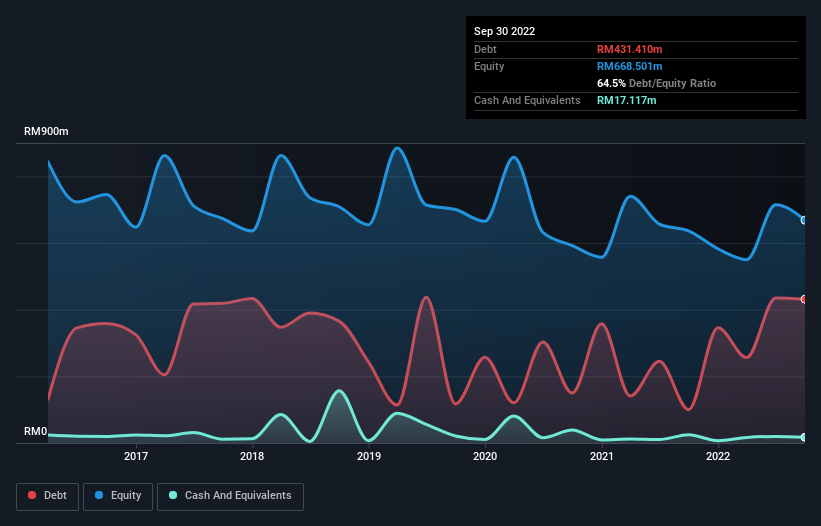Here's Why Nestlé (Malaysia) Berhad (KLSE:NESTLE) Can Manage Its Debt Responsibly

David Iben put it well when he said, 'Volatility is not a risk we care about. What we care about is avoiding the permanent loss of capital.' When we think about how risky a company is, we always like to look at its use of debt, since debt overload can lead to ruin. Importantly, Nestlé (Malaysia) Berhad (KLSE:NESTLE) does carry debt. But should shareholders be worried about its use of debt?
What Risk Does Debt Bring?
Debt and other liabilities become risky for a business when it cannot easily fulfill those obligations, either with free cash flow or by raising capital at an attractive price. Part and parcel of capitalism is the process of 'creative destruction' where failed businesses are mercilessly liquidated by their bankers. However, a more common (but still painful) scenario is that it has to raise new equity capital at a low price, thus permanently diluting shareholders. By replacing dilution, though, debt can be an extremely good tool for businesses that need capital to invest in growth at high rates of return. The first step when considering a company's debt levels is to consider its cash and debt together.
See our latest analysis for Nestlé (Malaysia) Berhad
How Much Debt Does Nestlé (Malaysia) Berhad Carry?
As you can see below, at the end of September 2022, Nestlé (Malaysia) Berhad had RM431.4m of debt, up from RM100.0m a year ago. Click the image for more detail. However, it does have RM17.1m in cash offsetting this, leading to net debt of about RM414.3m.

A Look At Nestlé (Malaysia) Berhad's Liabilities
According to the last reported balance sheet, Nestlé (Malaysia) Berhad had liabilities of RM2.18b due within 12 months, and liabilities of RM669.9m due beyond 12 months. Offsetting this, it had RM17.1m in cash and RM515.3m in receivables that were due within 12 months. So it has liabilities totalling RM2.31b more than its cash and near-term receivables, combined.
Of course, Nestlé (Malaysia) Berhad has a market capitalization of RM32.7b, so these liabilities are probably manageable. But there are sufficient liabilities that we would certainly recommend shareholders continue to monitor the balance sheet, going forward. Carrying virtually no net debt, Nestlé (Malaysia) Berhad has a very light debt load indeed.
In order to size up a company's debt relative to its earnings, we calculate its net debt divided by its earnings before interest, tax, depreciation, and amortization (EBITDA) and its earnings before interest and tax (EBIT) divided by its interest expense (its interest cover). The advantage of this approach is that we take into account both the absolute quantum of debt (with net debt to EBITDA) and the actual interest expenses associated with that debt (with its interest cover ratio).
Nestlé (Malaysia) Berhad's net debt is only 0.40 times its EBITDA. And its EBIT covers its interest expense a whopping 57.0 times over. So we're pretty relaxed about its super-conservative use of debt. The good news is that Nestlé (Malaysia) Berhad has increased its EBIT by 7.4% over twelve months, which should ease any concerns about debt repayment. The balance sheet is clearly the area to focus on when you are analysing debt. But it is future earnings, more than anything, that will determine Nestlé (Malaysia) Berhad's ability to maintain a healthy balance sheet going forward. So if you want to see what the professionals think, you might find this free report on analyst profit forecasts to be interesting.
Finally, a company can only pay off debt with cold hard cash, not accounting profits. So we clearly need to look at whether that EBIT is leading to corresponding free cash flow. During the last three years, Nestlé (Malaysia) Berhad produced sturdy free cash flow equating to 67% of its EBIT, about what we'd expect. This free cash flow puts the company in a good position to pay down debt, when appropriate.
Our View
Happily, Nestlé (Malaysia) Berhad's impressive interest cover implies it has the upper hand on its debt. And the good news does not stop there, as its net debt to EBITDA also supports that impression! Zooming out, Nestlé (Malaysia) Berhad seems to use debt quite reasonably; and that gets the nod from us. While debt does bring risk, when used wisely it can also bring a higher return on equity. When analysing debt levels, the balance sheet is the obvious place to start. However, not all investment risk resides within the balance sheet - far from it. Be aware that Nestlé (Malaysia) Berhad is showing 2 warning signs in our investment analysis , and 1 of those is potentially serious...
If you're interested in investing in businesses that can grow profits without the burden of debt, then check out this free list of growing businesses that have net cash on the balance sheet.
Valuation is complex, but we're here to simplify it.
Discover if Nestlé (Malaysia) Berhad might be undervalued or overvalued with our detailed analysis, featuring fair value estimates, potential risks, dividends, insider trades, and its financial condition.
Access Free AnalysisHave feedback on this article? Concerned about the content? Get in touch with us directly. Alternatively, email editorial-team (at) simplywallst.com.
This article by Simply Wall St is general in nature. We provide commentary based on historical data and analyst forecasts only using an unbiased methodology and our articles are not intended to be financial advice. It does not constitute a recommendation to buy or sell any stock, and does not take account of your objectives, or your financial situation. We aim to bring you long-term focused analysis driven by fundamental data. Note that our analysis may not factor in the latest price-sensitive company announcements or qualitative material. Simply Wall St has no position in any stocks mentioned.
About KLSE:NESTLE
Nestlé (Malaysia) Berhad
Manufactures and sells food and beverage products in Malaysia and internationally.
Moderate growth potential with mediocre balance sheet.
Market Insights
Community Narratives


